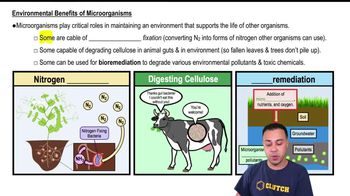NAME IT What type of microorganism has a peptidoglycan cell wall, has DNA that is not contained in a nucleus, and has flagella?
Which of the following is an example of bioremediation?
a. application of oil-degrading bacteria to an oil spill
b. application of bacteria to a crop to prevent frost damage
c. fixation of gaseous nitrogen into usable nitrogen
d. production by bacteria of a human protein such as interferon
e. all of the above
 Verified step by step guidance
Verified step by step guidance
Verified video answer for a similar problem:
Key Concepts
Bioremediation

Microbial Metabolism

Environmental Applications of Microbiology

It has been said that bacteria are essential for the existence of life on Earth. Which of the following is the essential function performed by bacteria?
a. control insect populations
b. directly provide food for humans
c. decompose organic material and recycle elements
d. cause disease
e. produce human hormones such as insulin
DRAW IT Show where airborne microbes ended up in Pasteur’s experiment. <IMAGE>
Spallanzani’s conclusion about spontaneous generation was challenged because Antoine Lavoisier had just shown that oxygen was the vital component of air. Which of the following statements is true?
a. All life requires air.
b. Only disease-causing organisms require air.
c. Some microbes do not require air.
d. Pasteur kept air out of his biogenesis experiments.
e. Lavoisier was mistaken.
Use the following choices to answer questions 9 and 10.
1. 9 + 2 flagella
2. 70s ribosome
3. fimbria
4. nucleus
5. peptidoglycan
6. plasma membrane
Which is (are) found only in prokaryotes?
a. 1,4,6
b. 3,5
c. 1,2
d. 4
e. 2,4,5
Bergey’s Manual of Systematics of Archaea and Bacteria differs from Bergey’s Manual of Determinative Bacteriology in that the former
a. groups bacteria into species.
b. groups bacteria according to phylogenetic relationships.
c. groups bacteria according to pathogenic properties.
d. groups bacteria into 19 species.
e. all of the above
